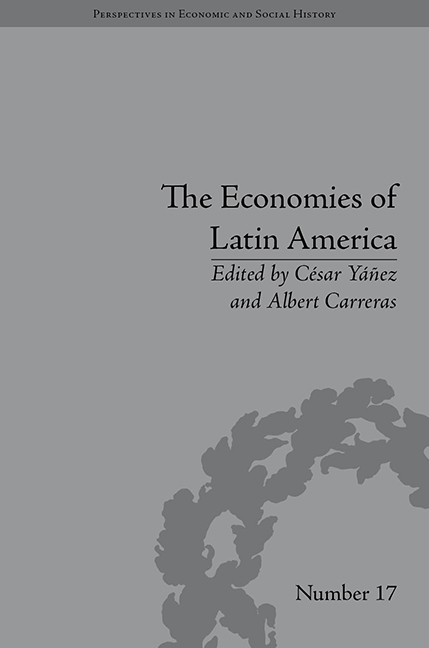Book contents
- Frontmatter
- CONTENTS
- List of Figures and Tables
- List of Contributors
- Preface
- Introduction: Latin American Economic Backwardness Revisited
- 1 Expectations, Institutions and Economic Performance: Latin America and the Western European Periphery during the Twentieth Century
- 2 On the Accuracy of Latin American Trade Statistics: A Non-Parametric Test for 1925
- 3 Latin America and Its Main Trade Partners, 1860–1930: Did the First World War Affect Geographical Patterns?
- 4 The Structure of Latin American Investment in Equipment Goods during the Mature Period of the First Globalization
- 5 Factorial Distribution of Income in Latin America, 1950–2000: New Series from the National Account Data
- 6 The Influence of the First World War on the Economies of Central America, 1900–29: An Analysis From a Foreign Trade Perspective
- 7 Economic Modernization in Adverse Institutional Environments: The Cases of Cuba and Chile
- 8 Capital Goods Imports, Machinery Investment and Economic Development in the Long Run: The Case of Chile
- 9 The Sugar Industry, the Forests and the Cuban Energy Transition, from the Eighteenth Century to the Mid-Twentieth Century
- 10 Empirical Debate on Terms Of Trade and the Double Factorial Terms of Trade of Colombia, 1975–2006
- 11 Public Revenues in Bolivia, 1900–31
- 12 The Consumption of Durable Goods in Latin America, 1890–1913: Analysis and Estimation of a Demand Function
- Notes
- Index
12 - The Consumption of Durable Goods in Latin America, 1890–1913: Analysis and Estimation of a Demand Function
- Frontmatter
- CONTENTS
- List of Figures and Tables
- List of Contributors
- Preface
- Introduction: Latin American Economic Backwardness Revisited
- 1 Expectations, Institutions and Economic Performance: Latin America and the Western European Periphery during the Twentieth Century
- 2 On the Accuracy of Latin American Trade Statistics: A Non-Parametric Test for 1925
- 3 Latin America and Its Main Trade Partners, 1860–1930: Did the First World War Affect Geographical Patterns?
- 4 The Structure of Latin American Investment in Equipment Goods during the Mature Period of the First Globalization
- 5 Factorial Distribution of Income in Latin America, 1950–2000: New Series from the National Account Data
- 6 The Influence of the First World War on the Economies of Central America, 1900–29: An Analysis From a Foreign Trade Perspective
- 7 Economic Modernization in Adverse Institutional Environments: The Cases of Cuba and Chile
- 8 Capital Goods Imports, Machinery Investment and Economic Development in the Long Run: The Case of Chile
- 9 The Sugar Industry, the Forests and the Cuban Energy Transition, from the Eighteenth Century to the Mid-Twentieth Century
- 10 Empirical Debate on Terms Of Trade and the Double Factorial Terms of Trade of Colombia, 1975–2006
- 11 Public Revenues in Bolivia, 1900–31
- 12 The Consumption of Durable Goods in Latin America, 1890–1913: Analysis and Estimation of a Demand Function
- Notes
- Index
Summary
Introduction
Consumption is related to economic growth, standards of living, income distribution, urbanization, demographic structure and the modernization of a society, among other factors. Aggregate consumption has become a main source of data about living standards as it may capture welfare levels, and it is an indicator of standards of living as it constitutes an important component in people's welfare. The types of goods consumed in a society and their variations over time yield information about standards of living and income distribution in that society. The incorporation of new goods into the consumption basket may be a result of economic progress in the sense that it may contribute to improving people's welfare, if these goods improve life quality in its different aspects – food, housing, transport, recreation – or make it possible to maintain life quality at a lower cost.
The period from the closing decades of the nineteenth century until the Great Depression, is considered the ‘golden age’ for most of the Latin American countries. The region enjoyed rapid growth based on the export of natural resources, although it remained a net importer of manufactured goods. The first globalization was characterized by decreasing transport costs and increasing trade, and the internal prices of goods converged to international levels. This period of big exports and economic growth made it possible to import consumer goods.
I work with series of durable goods for the period from 1890 until the First World War for six countries: Argentina, Brazil, Chile, Cuba, Mexico and Uruguay.
- Type
- Chapter
- Information
- The Economies of Latin AmericaNew Cliometric Data, pp. 179 - 190Publisher: Pickering & ChattoFirst published in: 2014



